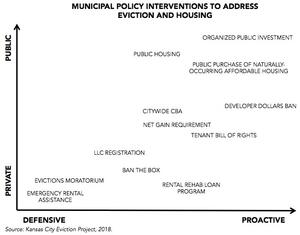
Municipal Policy Interventions to Address Evictions
by Tara Raghuveer, Founder and Director, Kansas City Eviction Project
What will it take to guarantee that every person in Kansas City has a truly and permanently affordable, healthy, accessible, and safe home? As municipal leaders grapple with this question, solutions must go beyond eviction-specific measures, as I described in a previous blog post. Municipalities need comprehensive solutions to address the housing crisis and to create systemic and long-lasting change.
A comprehensive housing strategy requires approaches that meet both urgent and structural challenges. Some interventions (like emergency rental assistance programs) respond to urgent crises, and others (like community land trusts) can address evictions’ root causes. Measures like a tenant bill of rights offer protections within the private market, and other investments will move housing into the public realm.
Housing justice is central to racial justice. America’s history of racial injustice endures in our neighborhoods, and housing insecurity disproportionately affects people of color. Although most housing policies can be thought of as racial justice interventions, cities should also pursue policies with explicit racial justice outcomes (like ban the box, described below).
A comprehensive housing agenda should include interventions that leverage public funding, regulate the private rental market, protect tenants, and establish structural reforms that fundamentally change how we make housing policy.
Public Funding and Supply
After decades of disinvestment, only one in five households qualifying for federal housing assistance receives it. This leaves cities and states to invest in housing policy and programs, but most cities spend less than 2 percent of their budgets on housing. Minneapolis mayor Jacob Frey recently proposed a $50 million housing plan. Ensuring a place for low-income people, communities of color, and workers in cities like Kansas City and Minneapolis will require significant investment—at that scale, or likely much more. Cities can invest in the following:
- Public housing. Disinvestment, mismanagement, and public stigma have left public housing in a perilous state. Approximately 4 million families remain on public housing or Section 8 waiting lists nationwide. Residents live in toxic and unsafe conditions. Demolishing or further disinvesting from public housing is not the answer. Cities can invest in rehabilitation (New York recently committed $1 billion to do) and expand public housing beyond existing units.
- Public purchase of naturally occurring affordable housing. Kansas City enjoys a stock of naturally occurring affordable housing. Cities like it can impede displacement by purchasing that stock before speculation or demolition. Public financing can support cooperative ownership models, like community land trusts or limited-equity co-ops, that promote self-determination and long-term affordability for low-income residents. Public purchase offers an opportunity to invest in weatherization, renewable energy, and green materials. Such investments are not amenities but rather critical to a city’s sustainable future and to the preservation of its affordable housing stock.
- Rental Rehabilitation Loan Program. In Kansas City, City Hall has leveraged Community Reinvestment Act funds to rehabilitate owner-occupied housing. Kansas City and similar cities can create a loan pool for rental rehabilitation and enforce an affordability standard for funded units.
Market Regulation
Development and speculation are major drivers of displacement. Adopting a comprehensive plan to address the housing crisis will require cities to regulate their markets through interventions like these:
- Citywide community benefits agreements (CBAs). CBAs secure benefits for the local workforce and community, but many are negotiated on a one-off basis, drain resources, and take a long time. Detroit passed a citywide CBA ordinance to standardize a process for developments over $75 million, but few developments have met the threshold. Cities should adopt citywide CBAs but with appropriate thresholds, given average development size, and with robust affordability and local jobs commitments from developers. As part of CBAs, advocates have pushed “no net loss” provisions, or one-to-one replacement of affordable units lost in development. Considering current affordability gaps, CBAs should instead include “net gain” requirements that mandate a one-to-two or one-to-three replacement of affordable units. Community oversight committees should determine the most needed replacement housing (i.e., family housing or accessible units) and where it is built.
- Corporate landlord regulation. Kansas City, like many other communities, saw rampant real estate speculation after the foreclosure crisis. Corporate landlords and absentee investors can drive rents up, file for eviction more often, leave properties vacant, and lack accountability to the local community. Absentee landlords often own property through limited liability companies (LLCs), limiting transparency and accountability. Cities should enforce LLC registration programs to hold owners accountable. Even better, cities should levy antispeculation taxes to supplement local revenue and fund community-controlled affordable housing.
Tenant Protections
To advance housing as a human right and to protect tenants from discrimination or exploitation in the rental market, cities should ensure that their laws and enforcement mechanisms establish basic protections, such as these:
- Tenant bill of rights. Cities should pass tenant bills of rights, supported by investment and enforcement, establishing protections that deal with housing conditions, evictions, rent control, the right to organize, relocation assistance, and more. New York City and San Francisco have passed right to counsel laws, and our research on Kansas City shows representation can make a difference during eviction cases. Right to counsel is an important intervention but will not change the systems that bring tenants to eviction court, may not work in cities lacking the necessary saturation of lawyers, and may have an unintended consequence of increasing informal evictions.
- Ban the box. Securing housing when one has a criminal record is difficult, if not impossible; 48,000 people entering homeless shelters yearly come directly from prisons or jails. People of color, disproportionately affected by America’s incarceration system, most acutely feel the impacts in the rental market. “Ban the box” legislation typically restricts employers from inquiring about a job applicant’s criminal background during the hiring process, and some cities have applied ban the box to rental applications as well.
- Urgent eviction solutions. Some cities have implemented eviction moratoriums during extreme weather or rental assistance programs to prevent evictions. If done thoughtfully, moratoriums could decrease the most destabilizing evictions, like those during the school year. Our Kansas City eviction research finds that evictions affect student mobility, with long-term consequences for children. Cities can establish emergency rental assistance programs with adequate funds to meet the needs of qualifying applicants. Nonpayment of rent is the leading cause of evictions in Kansas City and elsewhere. In Seattle, research shows that evictions often occur over less than one month’s rent.
Structural Reform
The reforms listed above require substantial political will. In places like Kansas City, the real estate lobby spends money to oppose legislation that would add market regulations and tenant protections. Meanwhile, low-income tenants lack the adequate access and resources to win the changes they need in order to mitigate the impact of evictions. Cities can address this power imbalance by supporting these policies:
- Developer dollars ban. In places like Chicago and New York, the real estate lobby contributes substantial sums to local political races, raising questions about the ethics of approval and public financing for their projects, which can displace residents and change neighborhoods. Physical displacement because of development remains a subject of academic debate, but studies have found that low-income renters face displacement risks in gentrifying areas. To reduce conflicts of interest and ensure the integrity of municipal policymaking, cities can consider restricting individuals and corporations from dealings with zoning boards and planning committees for a specific window of time after a campaign contribution.
- Community organizing. Community organizing builds power among the people closest to the problem and therefore closest to the solutions. Cities will be wise to support local organizing efforts and to ensure that affected communities influence housing policy.
Policymakers are quick to raise questions about funding, especially for bold policy demands that tackle systemic inequities. Several of the ideas described above offer means for revenue generation, but I think the question must also be turned back to the policymakers. Mayors, councilmembers, and city hall staff regularly organize significant capital for marquee projects, like Kansas City’s streetcar or new airport. More frequently, municipalities find public funds to subsidize and incentivize private development, even when it adds relatively little of the type of housing the city truly needs, benefits a privileged few, and risks sparking gentrification and further displacement. Some of these municipal investments come with affordable housing commitments but not nearly at the scale needed to guarantee that everyone in Kansas City has a place to live. Housing plays a fundamental role in our communities. A comprehensive housing strategy warrants becoming every mayor’s marquee project, and it will require a corresponding investment of political and financial capital.
The views expressed are those of the author and should not be attributed to the How Housing Matters Initiative, the Urban Institute, their trustees, or their funders.
Photo by Tommy Brison/Shutterstock
